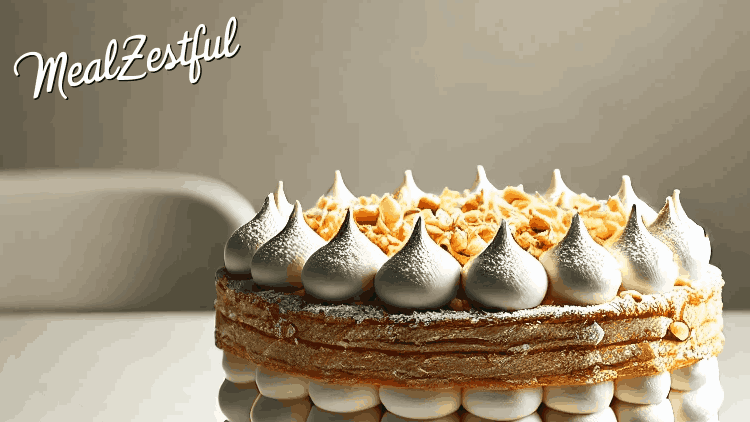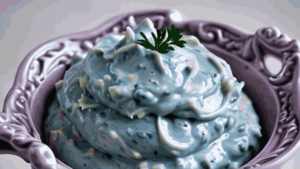Japonaise cake is a typical French cate that’s both light and ironic, containing layers of crisp almond meringue bursting with a subtle buttercream. It’s an agreeable grouping of textures and flavors, with a nutty crunch from the meringue and a flat, sugary stuffing. In this alignment, we’ll discover how to make Japonaise cake step by step, share tips for finalizing it, and suggest disparities you might enjoy.

What Is Japonaise cake?
Japonaise cake, also known as Gateau Japonaise, is a French cate made with layers of almond or hazelnut meringue, also called dacquoise, and a delicate stuffing like coffee or praline buttercream. Despite the name, this cake has no connection to Japan. The crisp meringue and smooth stuffing make it a succulent treat for any special occasion.
Constituents Required
- To make a traditional Japonaise cake, you’ll need the following constituents
- 4 large egg whites
- 1 mug granulated sugar
- mug almond flour (or finely ground hazelnuts)
- 1 teaspoon cornstarch
- 1 tablespoon vanilla excerpt
- 1 mug unsalted adulation, softened
- 1/2 mugs pulverized sugar
- 2 soupspoons strong coffee (for coffee buttercream)
- Diced nuts (for trim)
Why Use Almond Flour in Cake?
Almond flour is a crucial component in Japonaise cake because it adds a nutty flavor and a slightly leathery texture to the meringue layers. However, you can use finely base hazelnuts rather, which will give the cake a richer taste, If you prefer a different flavor. The almond or hazelnut flour also helps keep the meringue light and crisp.
1.How to Make the Meringue for Cake
launch by preheating your roaster to 300°F (150 °C) and lining two baking wastes with diploma paper. In a clean, dry coliseum, scourge the egg whites until they form soft peaks. Gradationally add the grained sugar, continuing to beat until stiff peaks form. Gently fold in the almond flour, cornstarch, and vanilla excerpt.
2.Pipeline the Meringue Disks
Transfer the meringue admixture to a pipeline bag fitted with a round tip. Pipe the meringue onto the set baking wastes in indeed circles, about 8 elevation in periphery. You should aim to produce three or four meringue disks, depending on the size of your cake. This will form the layers of the Japonaise cake.
3.Incinerating the Meringue Layers
Singe the meringue disks in the preheated roaster for about 45- 50 twinkles, or until they’re crisp and golden. Turn off the roaster and let the meringue cool fully inside to help cracking. The low baking temperature helps the meringue layers stay crisp while drying out sluggishly, giving them the perfect texture.
4.Preparing the Buttercream Filling
While the meringue is cooling, prepare the buttercream. In a mixing coliseum, beat the softened adulation until light and ethereal. Gradationally add the powdered sugar, beating until smooth. However, add the strong coffee a little at a time, blending until the admixture is delicate and well- combined, If you’re making coffee buttercream.
5.Assembling the Cake
Once the meringue layers are fully cool, it’s time to assemble the cake. Place one meringue fragment on a serving plate and spread a generous sub caste of buttercream over it. Repeat with the remaining layers, spreading buttercream between each. The rich, delicate stuffing contrasts beautifully with the crisp meringue.
6.Covering the cake with Buttercream
For a more polished look, spread a thin sub caste of buttercream over the top and sides of the Japonaise cake. This seals in the meringue layers and gives the cake a smooth finish. You can use a spatula or a pipeline bag to produce ornamental swirls or patterns if you like.
7.Garnishing the Japonaise cake
Finish the Japonaise cake by smattering diced nuts around the edges or on top. Almonds or hazelnuts are traditional, but you can also use pistachios for a pop of color. The trim not only adds texture but also highlights the nutty flavor of the cake.
8.Chilling the Cake Before Serving
To let the flavors immingle together, chill the assembled Japonaise cake in the refrigerator for at least 2 hours before serving. nipping helps the buttercream set and makes slicing easier. Let the cake sit at room temperature for 10- 15 twinkles before serving for the stylish texture.
9.Serving Suggestions for Japonaise cake
Japonaise cake is elegant enough to be served as a centerpiece cate at any festivity. It dyads wonderfully with a mug of coffee or tea, balancing the agreeableness of the cake with a bitter libation. For a redundant touch, serve each slice with a nugget of whipped cream or a mizzle of chocolate sauce.
Customizing Your Japonaise cake
You can fluently customize Cake to suit your taste. For a gooey twist, add a sub caste of jeer jam between the meringue disks. However, mix some cocoa greasepaint into the buttercream for a chocolatey stuffing, If you love chocolate. You can also experiment with different nut flours like pistachio or pecan.
Making Japonaise cake Gluten-Free
Japonaise cake is naturally gluten-free since it uses almond or hazelnut flour rather of wheat flour. This makes it a great option for those with gluten perceptivity. Just make sure to use cornstarch and double- check that all constituents are gluten-free if you’re serving it to someone with salutary restrictions.
Storing Japonaise cake
Store cake in the refrigerator, covered, for over to 3 days. The meringue layers will soften slightly over time as they absorb humidity from the buttercream, but the cake will still taste succulent. For a crisper texture, eat it within a day of assembling.
Can You indurate Japonaise cake?
Yes, you can indurate Japonaise cake if you want to make it ahead of time. Wrap the entire assembled cake or individual slices tightly in plastic serape, also place them in a freezer-safe vessel. indurate for over to 1 month. To serve, thaw the cake in the refrigerator overnight and bring to room temperature before eating.

Tips for the Perfect Japonaise cake
- Beat the egg whites duly. Make sure the egg whites reach stiff peaks before adding the almond flour.
- Cool the meringue fully. Let the meringue layers cool inside the roaster to avoid cracking.
- Chill before slicing. A stupefied cake is easier to cut and holds its shape more.
Common miscalculations to Avoid
One common mistake is under- whipping the egg whites, which can lead to a flat meringue. Make sure the egg whites are stiff and lustrous before adding the sugar. Another mistake is incinerating at too high a temperature, which can beget the meringue to brown or crack. Stick to a low heat for the stylish results.
Why Japonaise cake is a Crowd- Pleaser
Japonaise cake is a crowd- pleaser because it’s both light and decadent. The nutty meringue layers combined with a delicate stuffing produce a balanced cate that’s not exorbitantly sweet. It’s an elegant and emotional cate that’s perfect for any occasion, from family gatherings to formal fests.
Making Japonaise cake Dairy-Free
To make Japonaise cake dairy-free, you can use a vegan adulation cover for the buttercream and insure the rest of the constituents are dairy-free. There are numerous factory- grounded druthers that mimic the delicate texture of traditional adulation, so you can still enjoy a rich and succulent stuffing.
Adding Chocolate to Japonaise cake
For chocolate suckers, adding a sub caste of chocolate ganache to the Japonaise cake is a fantastic option. Simply melt dark chocolate with a bit of cream, also pour it over the top sub caste of the cake. The chocolate adds a decadent touch that dyads beautifully with the nutty meringue.
Conclusion
Japonaise cake is a stunning cate that combines crisp, nutty meringue layers with a smooth, delicate stuffing. It’s a classic French treat that’s both emotional and unexpectedly easy to make at home. Whether you’re a addict of traditional flavors or want to customize it with your favorite constituents, this cake is sure to impress everyone at the table.
Hope You Loved It! Try More Delightful Recipes, Click Here.
FAQs
1. Can I use hazelnuts rather of almonds for Japonaise cake?
Yes, ground hazelnuts work just as well and give the cake a richer, more violent flavor.
2. How do I keep the meringue layers from cracking?
Let the meringue layers cool in the roaster with the door slightly open to help unforeseen temperature changes that can beget cracking.
3. Can I use a different stuffing besides buttercream?
Absolutely! You can use whipped cream, cream frosting, or indeed a light scum as a stuffing.
4. How do I store leftover Japonaise cake?
Store leftover cake in the fridge, covered, for over to 3 days. The meringue layers may soften slightly, but it’ll still be succulent.
5. What’s the stylish way to cut Japonaise cake?
For clean slices, chill the cake first and use a sharp cutter. Wipe the cutter between cuts for the neatest donation.




